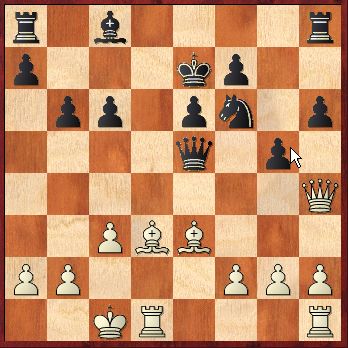The friendly G Grimbert was undoubtedly the strongest player present, so he took the opportunity to beat me and win the tournament.
Before leaving us, he gave me a mate in 3 moves that I looked for as soon as I arrived at the club, waiting for the Master to arrive.
It is in fact a twin: the Ws play and I mate in 3 moves. Then the same statement, but shifting all the pieces one file to the left.
I strongly advise the readers to look for these problems, they will not regret it after having found the not so difficult solutions since I found them in less than 30'.
For the anecdote: when Alain arrived and saw this position on the chessboard in front of me, he immediately quoted the solution and the authors!
Let's move on to the lesson.
Firstly, the homework exercise given in the previous lesson.
I searched for it, but finding that 1:Kg7 b5; 2:Kxg6 b4; 3:Nf6 b3; 4:Nd5 b2; 5:Nc3 loses on the one hand because this K+P/N position wins and on the other hand because Kg6 is very badly placed, a clever way to intervene more quickly with N by losing only one K time is :
1:Ng5 b5; 2:Kg7 b4; 3:Ne4 b3 4:Nc4! b2; 5:Nd3+ and draw. Alas, there also B wins because they have a better suite at the 3rd move.
One can therefore think that it is too difficult and give up.
Knowing the solution, I absolutely advise you against it!
Knowing the above, I assert that the solution is findable (when we know it exists and that it is neither Kg7 nor Ng5).
To say that it is findable obviously means that one cannot launch into infinite trees of variants. You have to be very "forceful". What is great is that when you have found it, you have understood the essential in the N vs P struggle.
We then only examined one study, but this is because to really understand it, it was necessary to dig out many variations.
White to play and draw.
As I said, looking directly at the solution gives a lot of pleasure but does not bring much. To understand this study, you need to clarify 1:Rxh7 and 1:exf4 (where Rxf4? 2:Rxa7! would draw). In this kind of positions (just like in the endgame), culture plays an essential role in the sense that to choose a plan or a move, one must correctly evaluate the different candidate plans or moves. And to do this, one must push the analysis until one encounters positions that one can judge without error. The more solid the culture, the closer this calculation horizon is and that makes all the difference.
Two exercises "to do at home".
1st: find the W win (the fastest)
2nd: W's make a draw.
The game of the day between two K's, but where Kasparov only intervenes as an object of preparation.
Kamsky - Karpov (1993, the date being important for the theoretical aspect).
1.e4 c6 2.d4 d5 3.Nd2 dxe4 4.Nxe4 Nd7 5.Ng5 Ngf6 6.Bd3 e6 7.N1f3 Bd6 [Karpov says that Be7, Qc7 and h6 are possible. So he considers that 7...h6 8.Nxe6 is not to be feared. Yet Deep Blue showed against Kasparov in 1997 that it was winning.]
8.Qe2 h6 9.Ne4 [ Karpov says that 9.Nxe6 is harmless, which is wrong even if it is not necessarily winning]
9...Nxe4 10.Qxe4 Nf6 11.Qh4 Ke7!!
A theoretical novelty that Karpov says he prepared for his match against Kasparov. On the one hand, this move threatens to win a piece by g5-g4, on the other hand it seems to be the only serious move, the others being bad. [For example 11...0-0? 12.Bxh6 gxh6 13.Qxh6 +- because 13...Re8? is refuted by 14.Ng5 which is a much stronger move when the R is no longer on f8. Hence the obvious continuation (when you have understood everything) 13...c5 14.g4! Re8 15.Ng5!+-]
12.Ne5! (the only move) 12...Bxe5 13.dxe5 Qa5+ 14.c3 Qxe5+ 15.Be3 b6 16.0–0–0 g5!?

[A move I cannot bring myself to validate. The lasting weakening of the B-squares seems unacceptable to me. Of course, I agree that this kind of consideration is totally obvious to Karpov and that if he played this move here in spite of the safety principles of K, it is by relying on a very precise calculation and by having foreseen continuations fighting against the W control of the black squares.
Nevertheless, if I conceive that this move is good at Karpov's level, I remain convinced that it would be a big mistake at a 2000-2200 level with a good tactical player on the W side].
17.Qa4 c5 18.Rhe1 Bd7 19.Qa3 Rhd8 20.g3 Qc7 21.Bd4 Be8 22.Kb1 Rd5 23.f4 Rad8
24.Bc2 R5d6 25.Bxf6+ Kxf6 26.fxg5+ hxg5 27.Rxd6 Rxd6 28.c4 Ke7 29.Qe3 f6 30.h4! The W's proposed a draw, and contrary to what Karpov says, there is no B-advantage, the advance of an h-pawn against two linked pawns "e" and "f" being insufficient in the Rook endgame but being sufficient in the Bishop endgame.
30...gxh4 31.gxh4 Qd7 32.Qh6 e5 33.h5? [33.Rg1!] 33:..Qg4! [empêche le plan Qg7+ suivi de h6]
34.Qh7+ Kd8? 35.h6! Rd2 36.Qf5? [36.Qxa7!] 36...Qxf5 37.Bxf5 Bd7? [37...Rh2! still secured a draw] 38.Bg6? [38.Kc1! Rd4 39.Be4! +-] 38...Rh2 39.h7 Ke7 and now it's lost, the moves don't matter so much, we've accelerated and I've stopped noting.. 0–1
I am now joining the Master's report, as prompt as ever.
Hoping that the next session (January 29) will not give the Master Clerk another false (exit) order.
Add a comment